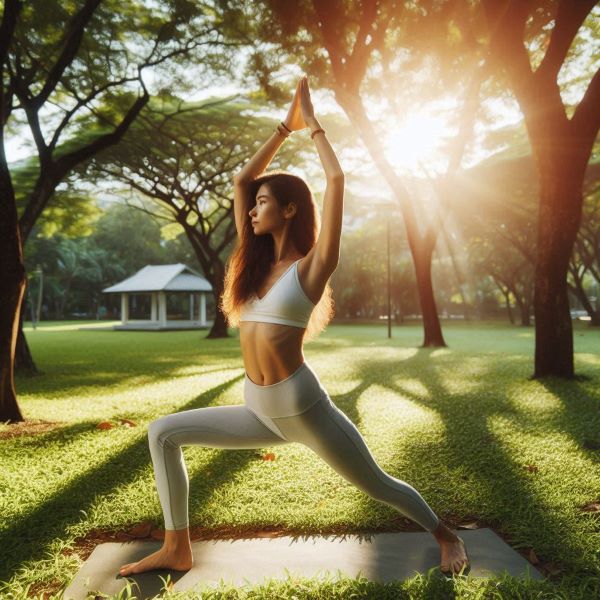Trikonasana, known in English as the Triangle Pose, is a fundamental standing yoga posture that enhances balance, flexibility, and strength. The name is derived from the Sanskrit words “Trikona” (triangle) and “Asana” (pose), reflecting the triangular shape created by the body’s position. Trikonasana is renowned for its ability to stretch and strengthen various muscle groups while promoting overall stability.
Quickly Learn all about Trikonasana- Triangle Posture History
Trikonasana is a staple in Hatha Yoga, one of the oldest forms of yoga that emphasizes physical postures and breathing techniques. The pose has been practiced for centuries, with references found in ancient yogic texts. It is considered one of the essential asanas for preparing the body for more advanced postures, integrating physical alignment with mental focus.
How to Do Trikonasana Steps?
To perform Trikonasana correctly, follow these steps:
- Starting Position: Stand in Tadasana (Mountain Pose) with your feet together and arms by your sides. Take a deep breath and step your feet about 3-4 feet apart.
- Positioning the Feet: Turn your right foot out 90 degrees so that your toes point to the right, and your left foot slightly inward at about 45 degrees. Align the heels of both feet.
- Extending the Arms: Inhale and raise your arms parallel to the floor, extending them out to the sides with palms facing down. Ensure your shoulders are relaxed and not hunched.
- Bending the Body: Exhale and extend your torso to the right, bending from the hip joint (not the waist). Keep your legs straight and firm, with your knees unbent.
- Placing the Hand: Place your right hand on your shin, ankle, or the floor outside your right foot, depending on your flexibility. Stretch your left arm toward the ceiling, in line with your shoulders.
- Aligning the Body: Turn your head to look at your left hand. Keep your body in a straight line from the top of your head to your tailbone. Avoid leaning forward or backward.
- Holding the Pose: Hold the pose for 5-10 breaths, maintaining steady and deep breathing. Focus on maintaining balance and alignment.
- Releasing the Pose: Inhale and lift your torso back to an upright position. Lower your arms and repeat the pose on the opposite side.
Trikosana Benefits
Practicing Trikonasana regularly offers several health benefits, including:
- Improving Flexibility: Stretches the hamstrings, groin, and hips, enhancing overall flexibility.
- Strengthening Muscles: Tones the legs, knees, ankles, arms, and chest.
- Enhancing Balance: Improves balance and stability by strengthening the core and leg muscles.
- Stimulating Organs: Stimulates abdominal organs, aiding in digestion and reducing bloating.
- Reducing Stress: Calms the mind and relieves stress through focused breathing and stretching.
Who Should Do Trikonasana Pose?
Trikonasana is beneficial for most individuals, especially those who:
- Want to improve their overall flexibility and strength.
- Seek to enhance their balance and coordination.
- Experience mild back or hip discomfort.
- Are looking to integrate a foundational pose into their yoga practice.
Also, read: Quickly Learn all about Tadasana – Palm Tree Pose
Who Should Not Do Trikonasana Yoga?
Certain individuals should take precautions or avoid practicing Trikonasana:
- Those with severe back or neck injuries.
- Individuals with chronic knee or ankle issues.
- Pregnant women should practice under the guidance of a yoga instructor to ensure proper modifications.
- People with high or low blood pressure should consult a healthcare provider before practicing this pose.
Precautions to Take
When practicing Trikonasana, keep these precautions in mind:
- Avoid hyperextending the knees; keep a micro-bend to prevent strain.
- Ensure the alignment of the body, avoiding leaning too far forward or backward.
- Engage your core muscles to support the spine and maintain balance.
- If you experience dizziness or discomfort, come out of the pose and rest.
References and Sources:
Iyengar, B. K. S. (1979) [1966]. Light on Yoga: Yoga Dipika. Unwin Paperbacks. ISBN 978-1855381667.
By incorporating Trikonasana into your regular yoga practice, you can enjoy its numerous benefits while developing a strong foundation for more advanced poses. Always practice mindfully and consult with a yoga instructor if you have any health concerns.





